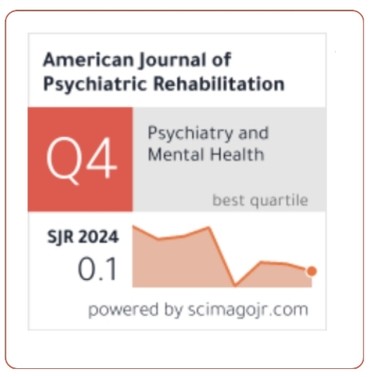Virtual Reality's Efficacy In Assessing And Treating Phobias And PTSD: A Literature Review
DOI:
https://doi.org/10.69980/ajpr.v28i5.466Keywords:
Phobia, virtual reality, PTSD, systematic review, treatmentAbstract
The study sought to determine the role of virtual reality in the assessment and treatment of phobias and post-traumatic stress disorder. The study employed the literature review method and reviewed 20 published articles for the study. These were studies that were based on primary research only. The study explored five specific types of phobia, which are small animal phobia, arachnophobia, acrophobia, fear of public speaking, and dental phobia. The study revealed that virtual reality provides an effective way of assessing and treating phobias and post-traumatic stress disorder (PTSD), especially where 360-degree videos and pictures are included. It provides an immersive method that allows the patients to face their fears rather than avoid them. It also offers a method that reduces avoidance behavior in patients compared to other treatment approaches. Advances in technology have resulted in the adoption of VR through the use of smartphones, and this could provide a great way for more widespread adoption of VR in treatments. There is still a need to improve the efficacy of VR by addressing its current limitations.
References
1. Andersson, J., Hallin, J., Tingström, A., & Knutsson, J. (2023). Virtual reality exposure therapy for fear of spiders: an open trial and feasibility study of a new treatment for arachnophobia. Nordic Journal of Psychiatry, 1-9.
2. Arias, M. C., & McNeil, D. W. (2020). Smartphone-based exposure treatment for dental phobia: a pilot randomized clinical trial. Journal of Public Health Dentistry, 80(1), 23–30.
3. Belsher, B. E., Beech, E., Evatt, D., Smolenski, D. J., Shea, M. T., Otto, J. L., Rosen, C. S., & Schnurr, P. P. (2019). Present-centered therapy (PCT) for post-traumatic stress disorder (PTSD) in adults. The Cochrane database of systematic reviews, 2019(11), CD012898.
4. Bentz, D., Wang, N., Ibach, M. K., Schicktanz, N. S., Zimmer, A., Papassotiropoulos, A., & de Quervain, D. J. (2021). Effectiveness of a stand-alone, smartphone-based virtual reality exposure app to reduce fear of heights in real-life: a randomized trial. NPJ digital medicine, 4(1), 16.
5. Binder, F. P., Pöhlchen, D., Zwanzger, P., & Spoormaker, V. I. (2022). Facing your fear in immersive virtual reality: Avoidance behavior in specific phobia. Frontiers in Behavioral Neuroscience, 16, 827673.
6. Birckhead, B., Khalil, C., Liu, X., Conovitz, S., Rizzo, A., Danovitch, I., Bullock, K., & Spiegel, B. (2019). Recommendations for Methodology of Virtual Reality Clinical Trials in Health Care by an International Working Group: Iterative Study. JMIR mental health, 6(1), e11973.
7. Bisson, J. I., Van Deursen, R., Hannigan, B., Kitchiner, N., Barawi, K., Jones, K., ... & Vermetten, E. (2020). Randomized controlled trial of multi‐modular motion‐assisted memory desensitization and reconsolidation (3MDR) for male military veterans with treatment‐resistant post‐traumatic stress disorder. Acta Psychiatrica Scandinavica, 142(2), 141-151.
8. Brahm, C. O., Lundgren, J., Carlsson, S. G., Nilsson, P., & Hägglin, C. (2019). Evaluation of the Jönköping dental fear coping model: a patient perspective. Acta Odontologica Scandinavica, 77(3), 238-247.
9. Canella, R., Essoe, J. K. Y., Grados, M., & McGuire, J. F. (2020). Overcoming challenges in exposure therapy. Exposure Therapy for Children with Anxiety and OCD, 383-404.
10. Carl, E., Stein, A. T., Levihn-Coon, A., Pogue, J. R., Rothbaum, B., Emmelkamp, P., Asmundson, G. J. G., Carlbring, P., & Powers, M. B. (2019). Virtual reality exposure therapy for anxiety and related disorders: A meta-analysis of randomized controlled trials. Journal of anxiety disorders, 61, 27–36.
11. Difede, J., Rothbaum, B. O., Rizzo, A. A., Wyka, K., Spielman, L., Reist, C., ... & Lee, F. S. (2022). Enhancing exposure therapy for posttraumatic stress disorder (PTSD): a randomized clinical trial of virtual reality and imaginal exposure with a cognitive enhancer. Translational Psychiatry, 12(1), 299.
12. Eaton, W. W., Bienvenu, O. J., & Miloyan, B. (2018). Specific phobias. The Lancet Psychiatry, 5(8), 678-686.
13. Fonzo, G. A., Federchenco, V., & Lara, A. (2020). Predicting and Managing Treatment Non-Response in Posttraumatic Stress Disorder. Current treatment options in psychiatry, 7(2), 70–87.
14. Fox, V., Dalman, C., Dal, H., Hollander, A. C., Kirkbride, J. B., & Pitman, A. (2021). Suicide risk in people with post-traumatic stress disorder: A cohort study of 3.1 million people in Sweden. Journal of Affective Disorders, 279, 609–616.
15. Freeman, D., Haselton, P., Freeman, J., Spanlang, B., Kishore, S., Albery, E., ... & Nickless, A. (2018). Automated psychological therapy using immersive virtual reality for treatment of fear of heights: a single-blind, parallel-group, randomized controlled trial. The Lancet Psychiatry, 5(8), 625-632.
16. Gujjar, K. R., van Wijk, A., Kumar, R., & de Jongh, A. (2019). Efficacy of virtual reality exposure therapy for the treatment of dental phobia in adults: A randomized controlled trial. Journal of anxiety disorders, 62, 100-108.
17. Hamilton, T., Burback, L., Smith-MacDonald, L., Jones, C., Brown, M. R. G., Mikolas, C., Tang, E., O'Toole, K., Vergis, P., Merino, A., Weiman, K., Vermetten, E. H. G. J. M., & Brémault-Phillips, S. (2021). Moving Toward and Through Trauma: Participant Experiences of Multi-Modal Motion-Assisted Memory Desensitization and Reconsolidation (3MDR). Frontiers in psychiatry, 12, 3MDR
18. Huppert, D., Wuehr, M., & Brandt, T. (2020). Acrophobia and visual height intolerance: advances in epidemiology and mechanisms. Journal of Neurology, 267(Suppl 1), 231–240.
19. Kahlon, S., Lindner, P., & Nordgreen, T. (2019). Virtual reality exposure therapy for adolescents with fear of public speaking: a non-randomized feasibility and pilot study. Child and adolescent psychiatry and mental health, 13(1), 1-10.
20. Kahlon, S., Lindner, P., & Nordgreen, T. (2019). Virtual reality exposure therapy for adolescents with fear of public speaking: a non-randomized feasibility and pilot study. Child and adolescent psychiatry and mental health, 13(1), 1-10.
21. Kamkuimo, S. A., Girard, B., & Menelas, B.-A. J. (2021). A Narrative Review of Virtual Reality Applications for the Treatment of Post-Traumatic Stress Disorder. Applied Sciences, 11(15), 6683. MDPI AG
22. Kim, S., & Kim, E. (2020). The Use of Virtual Reality in Psychiatry: A Review. Soa--ch'ongsonyon chongsin uihak = Journal of child & adolescent psychiatry, 31(1), 26–32. https:// doi.org/10.5765/jkacap.190037
23. Knaust, T., Felnhofer, A., Kothgassner, O. D., Höllmer, H., Gorzka, R.-J., & Schulz, H. (2020). Virtual trauma interventions for the treatment of post-traumatic stress disorders: A scoping review. Frontiers in Psychology, 11, Article 562506.
24. Knaust, T., Felnhofer, A., Kothgassner, O. D., Reinke, M., Browning, M., Höllmer, H., & Schulz, H. (2022). Nature videos for PTSD: protocol for a mixed-methods feasibility study. European Journal of Psychotraumatology, 13(2), 2101765.
25. Kothgassner, O. D., Goreis, A., Kafka, J. X., Van Eickels, R. L., Plener, P. L., & Felnhofer, A. (2019). Virtual reality exposure therapy for posttraumatic stress disorder (PTSD): a meta-analysis. European Journal of Psychotraumatology, 10(1), 1654782.
26. Kourtesis, P., Collina, S., Doumas, L. A., & MacPherson, S. E. (2019). Validation of the virtual reality neuroscience questionnaire: maximum duration of immersive virtual reality sessions without the presence of pertinent adverse symptomatology. Frontiers in human neuroscience, 13, 417.
27. Lewis, C., Roberts, N. P., Gibson, S., & Bisson, J. I. (2020). Dropout from psychological therapies for post-traumatic stress disorder (PTSD) in adults: systematic review and meta-analysis. Journal of Psychotraumatology, 11(1), 1709709. https://doi.org/10.1080/20008198.2019.1709709
28. Lundin, R. M., Yeap, Y., & Menkes, D. B. (2023). Adverse Effects of Virtual and Augmented Reality Interventions in Psychiatry: Systematic Review. JMIR mental health, 10, e43240.
29. Lyu, A. (2021, April). Applications and Future Perspectives of Virtual Reality in the Treatments of Post-Traumatic Stress Disorder. In 2021 3rd International Conference on Intelligent Medicine and Image Processing (pp. 151-155).
30. Majidi, E., & Manshaee, G. (2021). Effects of Virtual Reality Exposure Therapy on Dentophobia in Clients of Dental Offices in Isfahan, Tehran, and Shahrekord (Iran). Iranian Journal of Psychiatry and Behavioral Sciences, 15(4).
31. Maples-Keller, J. L., Yasinski, C., Manjin, N., & Rothbaum, B. O. (2017). Virtual Reality-Enhanced Extinction of Phobias and Post-Traumatic Stress. Neurotherapeutics: TheJournal of the American Society for Experimental Neurotherapeutics, 14(3), 554–563.
32. Meyerbröker, K., & Morina, N. (2021). The use of virtual reality in assessment and treatment of anxiety and related disorders. Clinical Psychology & Psychotherapy, 28(3), 466-476.
33. Minns, S., Levihn-Coon, A., Carl, E., Smits, J. A., Miller, W., Howard, D., ... & Powers, M. B. (2019). Immersive 3D exposure-based treatment for spider fear: A randomized controlled trial. Journal of Anxiety isorders, 61, 37-44.
34. National Centre for PTSD
https://www.ptsd.va.gov/understand/common/common_adults.asp accessed 17/11/23
35. Nijdam, M. J., & Vermetten, E. (2018). Moving forward in treatment of posttraumatic stress disorder: innovations to exposure-based therapy. European Journal of Psychotraumatology, 9(1),
36. Park, M. J., Kim, D. J., Lee, U., Na, E. J., & Jeon, H. J. (2019). A literature overview of virtual reality (VR) in treatment of psychiatric disorders: recent advances and limitations. Frontiers in psychiatry, 10, 505.
37. Peñate, W., Rivero, F., Viña, C., Herrero, M., Betancort, M., De la Fuente, J., ... & Fumero, A. (2019). The equivalence between virtual and real feared stimuli in a phobic adult sample: a neuroimaging study. Journal of Clinical Medicine, 8(12), 2139.
38. Peñate, W., Rivero, F., Viña, C., Herrero, M., Betancort, M., De la Fuente, J., Álvarez-Pérez, Y., et al. (2019). The Equivalence between Virtual and Real Feared Stimuli in a Phobic Adult Sample: A Neuroimaging Study. Journal of Clinical Medicine, 8(12), 2139. MDPI AG
39. Rimer, E., Husby, L. V., & Solem, S. (2021). Virtual reality exposure therapy for fear of heights: Clinicians’ attitudes become more positive after trying VRET. Frontiers in Psychology, 12, 671871.
40. Ritter III, K. A., & Chambers, T. L. (2022). Three-dimensional modeled environments versus 360- degree panoramas for mobile virtual reality training. Virtual Reality, 26(2), 571-581.
41. Riva, G., & Serino, S. (2020). Virtual Reality in the Assessment, Understanding and Treatment of Mental Health Disorders. Journal of Clinical Medicine, 9(11), 3434.
42. Scheveneels, S., De Witte, N., & Van Daele, T. (2023). The first steps in facing your fears: The acceptability of virtual reality and in vivo exposure treatment for specific fears. Journal of Anxiety Disorders, 95, 102695.
43. Schröder, D., Wrona, K. J., Müller, F., Heinemann, S., Fischer, F., & Dockweiler, C. (2023). Impact of virtual reality applications in the treatment of anxiety disorders: A systematic review and meta-analysis of randomized-controlled trials. Journal of Behavior Therapy and Experimental Psychiatry, 101893.
44. Takac, M., Collett, J., Blom, K. J., Conduit, R., Rehm, I., & De Foe, A. (2019). Public speaking anxiety decreases within repeated virtual reality training sessions. PloS one, 14(5), e0216288.
45. Trahan, M. H., Morley, R. H., Nason, E. E., Rodrigues, N., Huerta, L., & Metsis, V. (2021). Virtual Reality Exposure Simulation for Student Veteran Social Anxiety and PTSD: A Case Study. Clinical Social Work Journal, 49(2), 220–230.
46. Van Dis, E. A., Landkroon, E., Hagenaars, M. A., van der Does, F. H., & Engelhard, I. M. (2021). Old fears die hard: Return of public speaking fear in a virtual reality procedure. Behavior Therapy, 52(5), 1188-1197.
47. Van Gelderen, M. J., Nijdam, M. J., de Vries, F., Meijer, O. C., & Vermetten, E. (2020). Exposure-related cortisol predicts outcome of psychotherapy in veterans with treatment-resistant posttraumatic stress disorder. Journal of Psychiatric Research, 130, 387-393.
48. Van Gelderen, M. J., Nijdam, M. J., Haagen, J. F., & Vermetten, E. (2020). Interactive motion-assisted exposure therapy for veterans with treatment-resistant posttraumatic stress disorder: a randomized controlled trial. Psychotherapy and Psychosomatics, 89(4), 215-227.
49. Van Meggelen, M., Morina, N., van der Heiden, C., Brinkman, W. P., Yocarini, I. E., Tielman, M. L., Rodenburg, J., van Ee, E., van Schie, K., Broekman, M. E., & Franken, I. H. A. (2022). A randomized controlled trial to pilot the efficacy of a computer-based intervention with elements of virtual reality and limited therapist assistance for the treatment of post-traumatic stress disorder. Frontiers in Digital Health, 4, 974668.
50. Verger, A., Rousseau, P. F., Malbos, E., Chawki, M. B., Nicolas, F., Lançon, C., ... & Guedj, E. (2020). Involvement of the cerebellum in EMDR efficiency: a metabolic connectivity PET study in PTSD. European journal of Psychotraumatology, 11(1), 1767986.
51. Vincent, C., Eberts, M., Naik, T., Gulick, V., & O'Hayer, C. V. (2021). Provider experiences of virtual reality in clinical treatment. PloS one, 16(10), e0259364.
52. Volovik, M. G., Belova, A. N., Kuznetsov, A. N., Polevaia, A. V., Vorobyova, O. V., & Khalak, M. E. (2023). Use of Virtual Reality Techniques to Rehabilitate Military Veterans with Post-Traumatic Stress Disorder (Review). Sovremennye Tekhnologii v Meditsine, 15(1), 74–85.
53. Walters, J., & Beidel, D. (2022). Getting Real about Post-Traumatic Stress Disorder in the Department of Defense: Augmenting Exposure Therapy through Virtual Reality. Journal of Veteran Studies 8(1), 87-97.
54. Weech, S., Kenny, S., & Barnett-Cowan, M. (2019). Presence and cybersickness in virtual reality are negatively related: a review. Frontiers in Psychology, 10, 158.
Downloads
Published
Issue
Section
License
Copyright (c) 2025 American Journal of Psychiatric Rehabilitation

This work is licensed under a Creative Commons Attribution 4.0 International License.
This is an Open Access article distributed under the terms of the Creative Commons Attribution 4.0 International License permitting all use, distribution, and reproduction in any medium, provided the work is properly cited.









